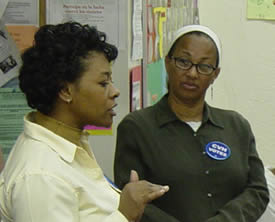Evaluation Overview
A successful evaluation strategy is integrated into the work of the electoral project and examines both the process and the results.
Simply stated, evaluation helps election organizers gauge the effectiveness of their work. In an initiative campaign, a win or a loss speaks volumes. In a non-partisan project, organizers can look at the voter file after the election to find out how many of the folks they contacted made it to the polls. But these measures are numerical and after-the-fact. They represent just one aspect of evaluation.
 A first-rate evaluation strategy looks at both quantitative and qualitative effects and is integrated into every stage of the electoral project, from planning to field organizing to post-election.
A first-rate evaluation strategy looks at both quantitative and qualitative effects and is integrated into every stage of the electoral project, from planning to field organizing to post-election.
As you lay out the field plan, you’ll include a schedule of periodic evaluations, opportunities that are built in to the ongoing project for organizers to revue the results of the work thus far, in terms of numerical targets as well as goals such as leadership development and community engagement. When the dust clears after Election Day, your organization will look at the project as a whole and assess its outcomes – again, both quantitatively and qualitatively. In the video, Henry Serrano describes how Community Voices Heard evaluates the dual elements of their election work.
A comprehensive evaluation allows organizers and membership to better understand the capacity of the organization and the scope of its newfound political power – and, of course, to prepare for even greater success in the next electoral cycle.
There are five steps of the integrated evaluation model:
- Planning: The key to successful evaluation – and a successful electoral project – is to establish the parameters of evaluation at the outset. Once organizers have defined the goals of the project in the political context analysis and targeting phases, the next step is to design the methods of measuring both ongoing progress and the final results.
- Periodic, Quantitative: These evaluations are all about the numbers – and a test of your database. If you’re tracking the right information and volunteers have been able to keep up with the steady input, then you’ll be able to analyze how far you’ve come and how far you have to go.
- Periodic, Qualitative: Opportunities for organizers to review the effectiveness of the electoral work, as well as any unexpected developments in the landscape of the election. Keep in mind that there will be any number of surprises as Election Day approaches; some are worth responding to, but most aren’t.
- Post-electoral, Quantitative: Did you get 2,000 people to the polls as you planned to? Did you defeat the unjust initiative? These are the basic questions, but a community group that wants to build upon their successes in future election cycles goes deeper.
- Post-electoral, Qualitative: Membership, volunteers and staff review the decisions made during the electoral project, the project’s successes and failures, both big and small, and the effect of the electoral work on the organization.


 A first-rate evaluation strategy looks at both quantitative and qualitative effects and is integrated into every stage of the electoral project, from planning to field organizing to post-election.
A first-rate evaluation strategy looks at both quantitative and qualitative effects and is integrated into every stage of the electoral project, from planning to field organizing to post-election.